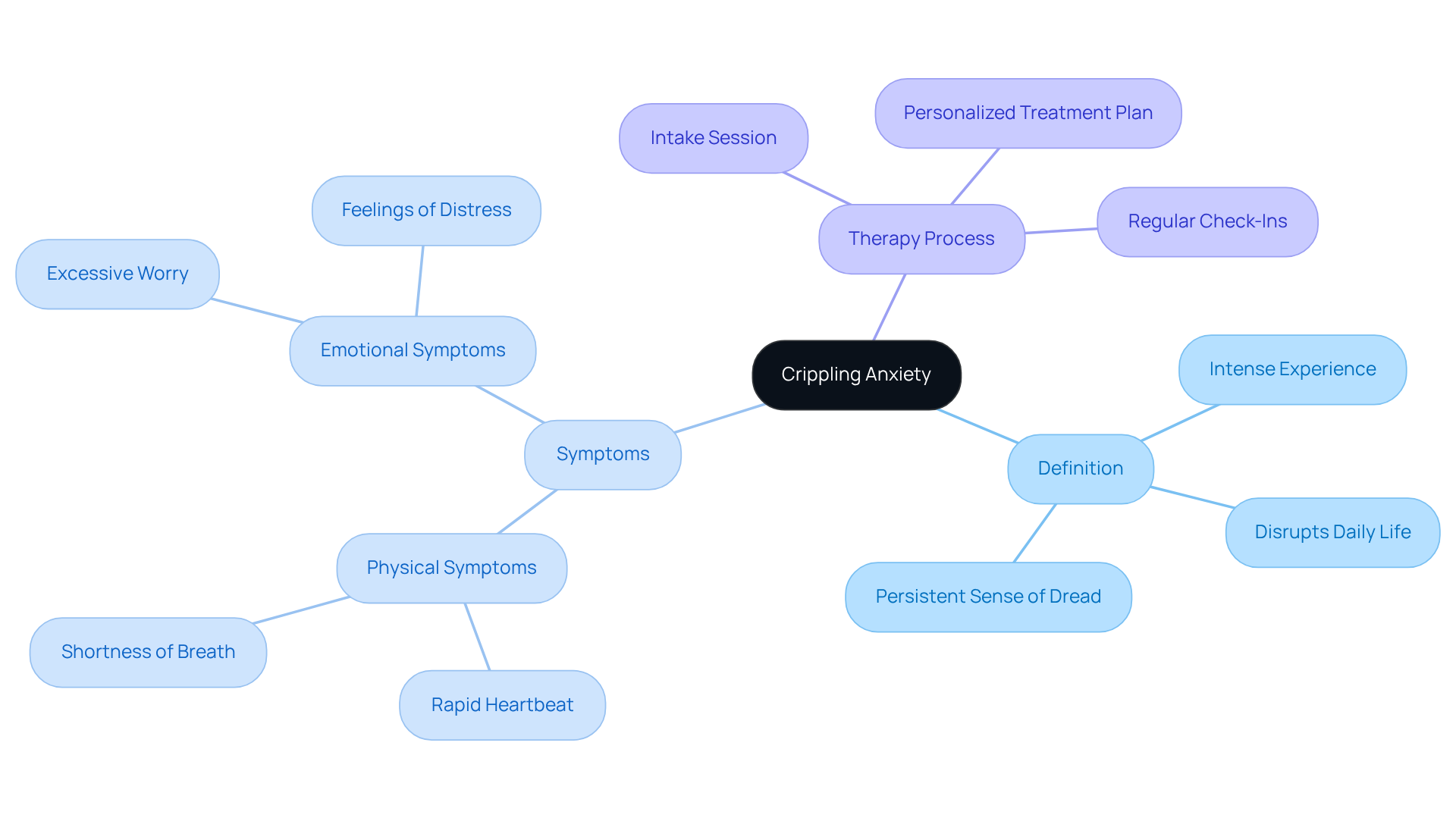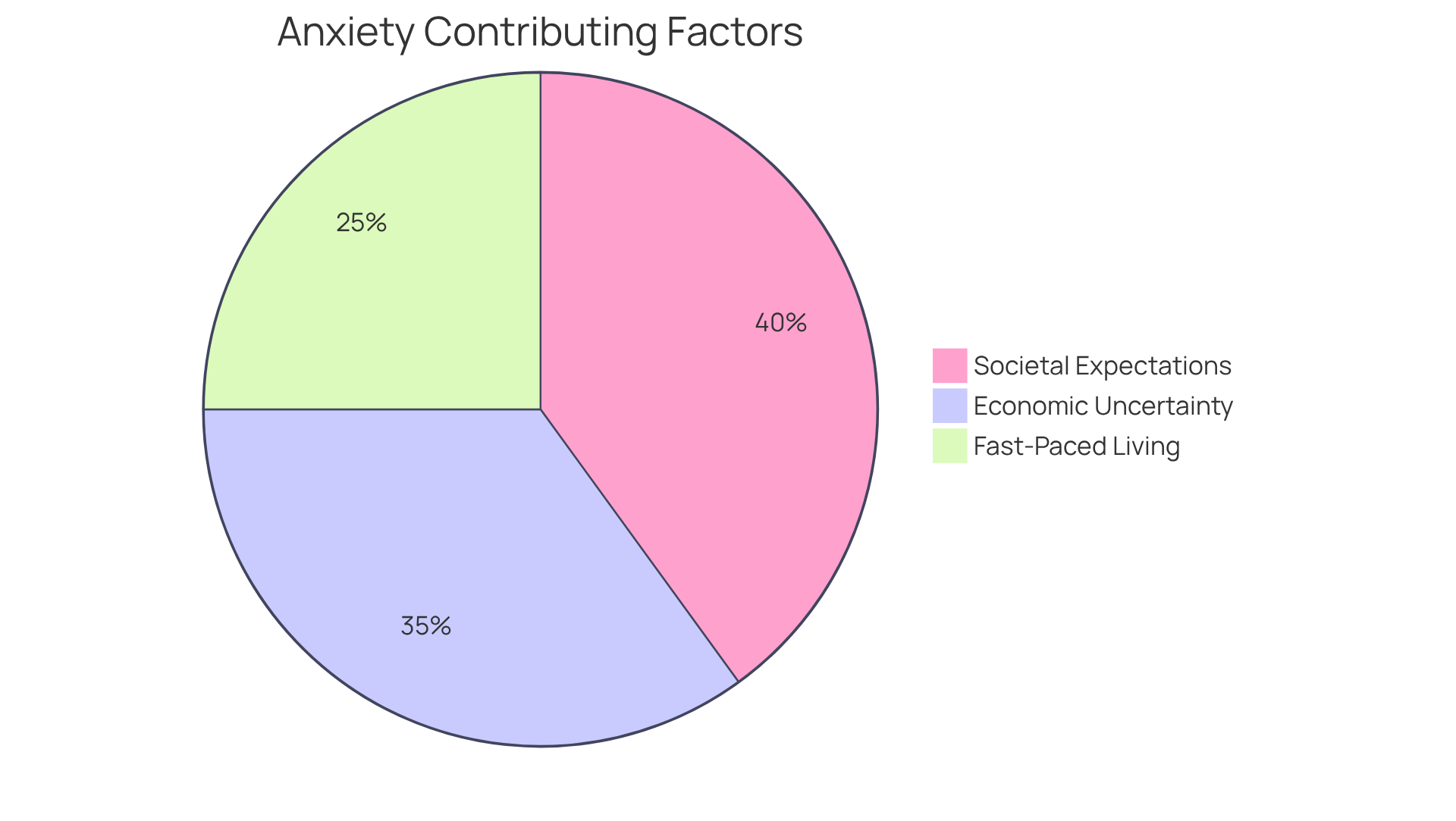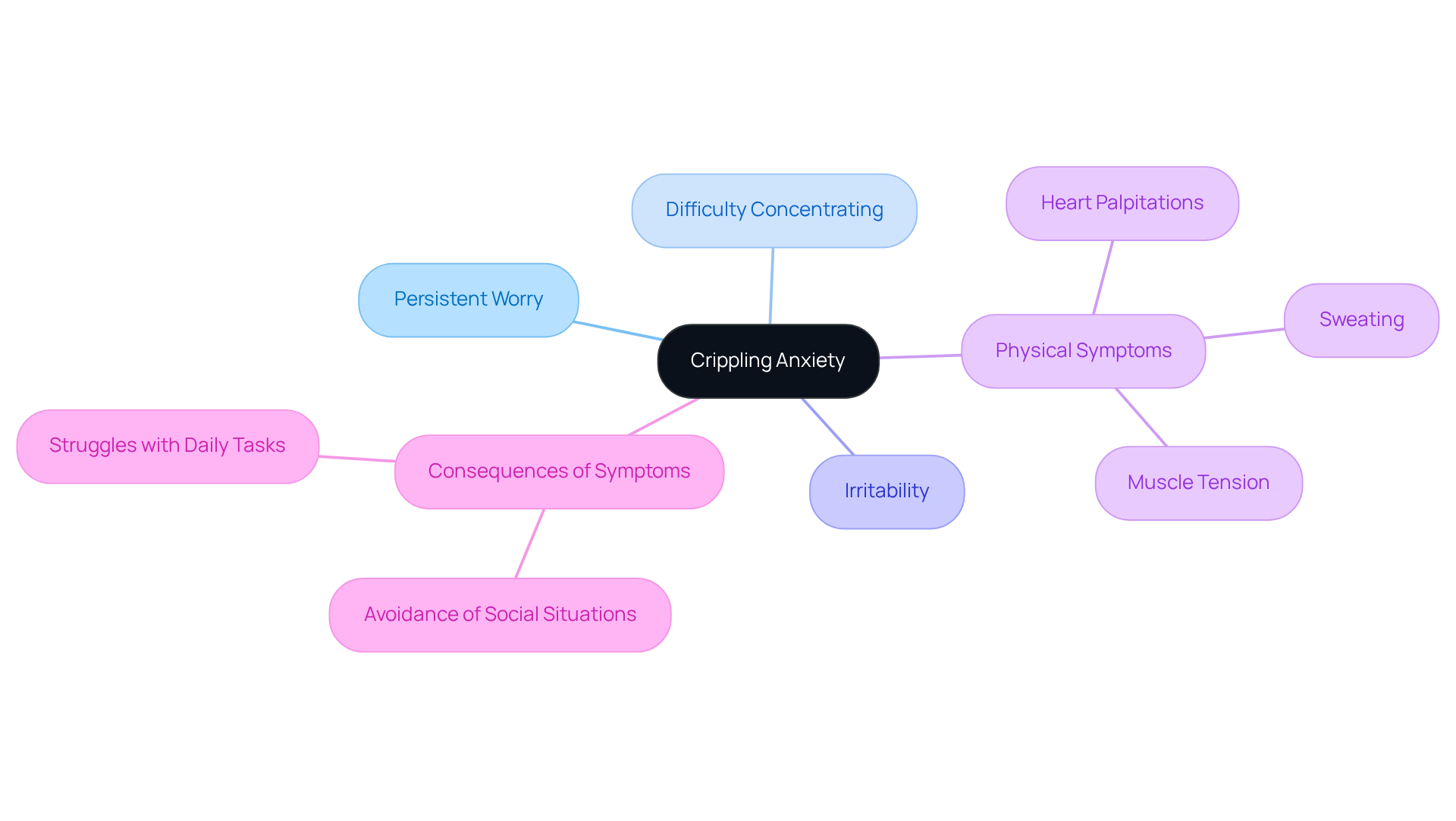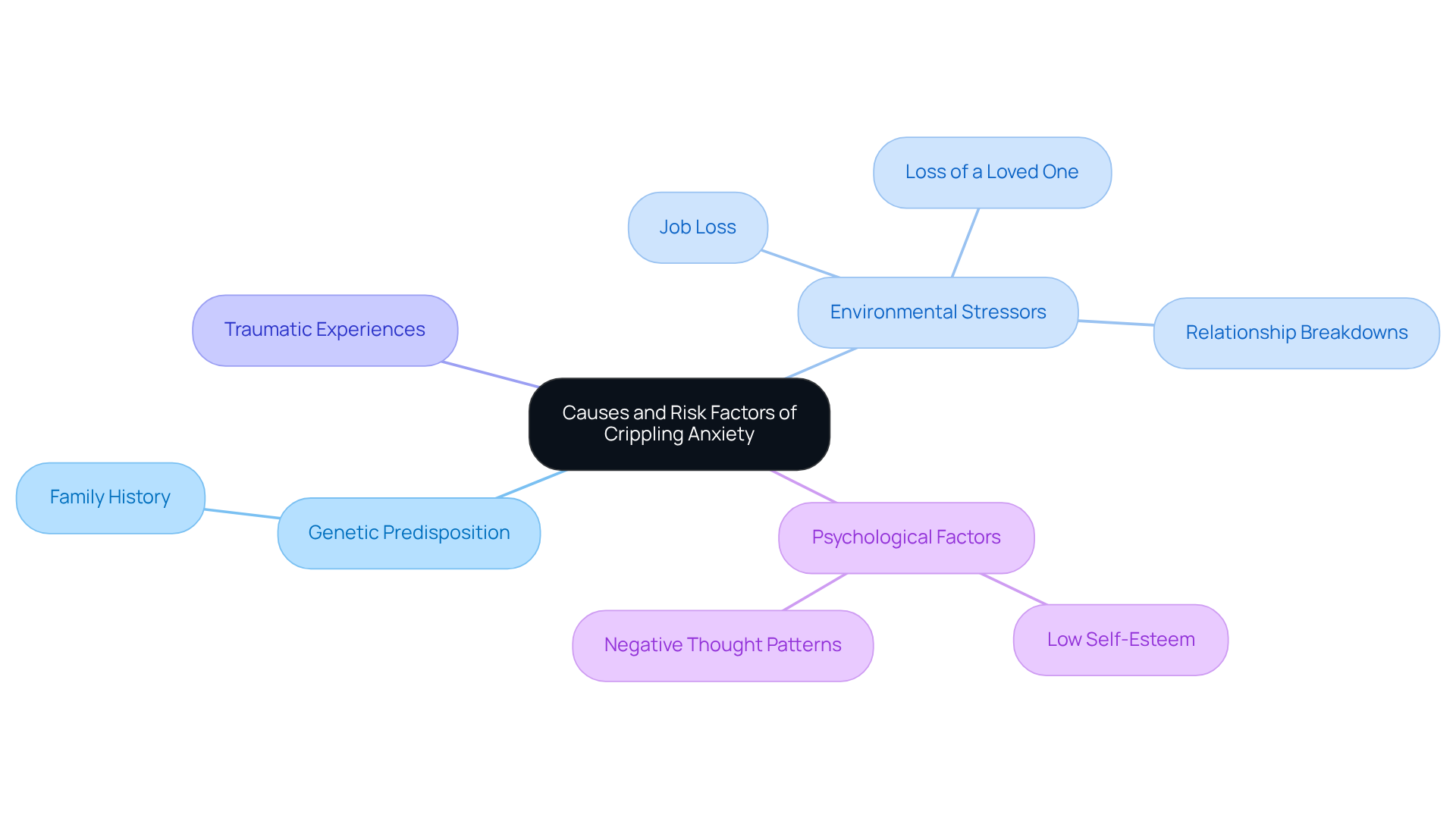Overview
Crippling anxiety can feel like an overwhelming weight, characterized by intense feelings that disrupt daily life. You might experience persistent worry, physical distress, or even find yourself avoiding social situations altogether. Understanding the causes—such as genetic predisposition and environmental stressors—is crucial for effective treatment and recovery.
Have you ever felt overwhelmed by your past? Recognizing these challenges is the first step towards healing. It’s important to seek help and support as you navigate this journey. Remember, you are not alone, and there are compassionate professionals ready to guide you through these difficult times.
Introduction
Crippling anxiety is not merely a fleeting feeling of worry; it signifies a profound struggle that can disrupt daily life and relationships. With nearly 20% of U.S. adults facing anxiety disorders each year, it becomes essential to understand its impact to foster awareness and compassion.
Have you ever felt overwhelmed by the pressures of modern life, leading to debilitating fear and avoidance? This exploration invites you to delve into the definition, symptoms, and underlying causes of crippling anxiety. By shedding light on a condition that affects countless individuals, we emphasize the importance of seeking help and the journey towards healing.
Defining Crippling Anxiety: A Comprehensive Overview
What is crippling anxiety can be described as an intense and overwhelming experience that greatly disrupts your ability to navigate daily life. Unlike common stress, which often feels manageable, what is crippling anxiety can create significant challenges in work, relationships, and overall well-being. Have you ever felt a persistent sense of dread or excessive worry? These feelings can manifest physically, too, with symptoms like a rapid heartbeat or shortness of breath. While not an official medical diagnosis, what is crippling anxiety captures the essence of distress that feels unmanageable and all-consuming.
At The Emerald Couch, we recognize that your journey to wellness is uniquely yours. Our therapy process begins with an intake session, where we gather essential information to collaboratively create a personalized treatment plan that caters to your specific needs. Most clients begin to notice improvements within 4 to 6 weeks as we work together to set achievable goals. Building a trusting therapeutic relationship is vital; we prioritize regular check-ins to ensure that the support you receive is effective and aligned with your recovery journey.
As we explore this further, remember that you are not alone in this experience. Seeking help is a courageous step towards healing, and we are here to support you every step of the way.

Context and Prevalence: The Impact of Crippling Anxiety in Modern Life
In our modern lives, many people are struggling with debilitating fear, which raises the question of what is crippling anxiety. Have you ever felt overwhelmed by the pressures around you? Studies reveal that stress-related disorders, which include what is crippling anxiety, affect about 19.1% of U.S. adults each year, with factors like societal expectations, economic uncertainty, and the fast-paced nature of contemporary living contributing to this rise in anxiety. The COVID-19 pandemic has only intensified these feelings, leading to heightened stress levels across various demographics. As awareness grows, more individuals are recognizing what is crippling anxiety as a significant mental health concern that deserves attention and intervention.
At The Emerald Couch, we understand the challenges you face. Our focus is on providing customized psychotherapy services tailored for trauma and stress disorders, including treatments for PTSD, OCD, and general worry. We offer both face-to-face counseling and telehealth options to accommodate the diverse needs of our clients. Our commitment to non-judgmental therapy fosters trusting relationships, allowing you to navigate your challenges and reclaim your life. Remember, seeking help is a courageous step towards healing, and we are here to support you on your journey.

Recognizing Symptoms: How Crippling Anxiety Affects Daily Life
Symptoms of debilitating stress can vary widely, often manifesting as persistent worry, difficulty concentrating, irritability, and physical signs like muscle tension, sweating, and heart palpitations. Have you ever felt overwhelmed by these feelings? Individuals may find themselves avoiding social situations or struggling to complete daily tasks, and some may even experience panic attacks. These signs can lead to a pattern of evasion and increased stress, making it even harder to engage in regular activities. Recognizing these symptoms is the first step toward seeking help and implementing effective coping strategies.
At The Emerald Couch, we understand that the journey to wellness is unique for each individual. Our customized therapy solutions are designed to meet your particular needs, ensuring you receive tailored support for trauma and stress recovery. Through a collaborative custom treatment planning process, we empower clients to define what success looks like for them. Typically, clients begin to feel better or notice some improvement within 4 to 6 weeks. We start with an intake session to gather essential information for your custom treatment plan, fostering a trusting therapeutic relationship that enhances effective healing. Together, we can navigate this path toward a brighter future.

Causes and Risk Factors: Understanding the Roots of Crippling Anxiety
Debilitating fear can emerge from a variety of sources, including genetic predisposition, environmental stressors, and traumatic experiences. Have you ever felt overwhelmed by your past? Those with a family history of anxiety disorders may find themselves more susceptible to developing debilitating stress. Additionally, significant life changes—such as the loss of a loved one, job loss, or relationship breakdowns—can trigger or amplify feelings of distress. Psychological factors, including low self-esteem and negative thought patterns, also play a vital role in defining what is crippling anxiety. Understanding these roots is essential for effective treatment and recovery. As we explore this further, remember that you are not alone in this journey. Seeking support can be a powerful step towards healing.

Conclusion
Crippling anxiety represents a profound and often overwhelming challenge, significantly interfering with daily functioning and overall well-being. This condition, marked by intense feelings of dread and excessive worry, can manifest in various physical and emotional symptoms. It is crucial to understand its implications and seek appropriate support. Recognizing the seriousness of crippling anxiety is the first step toward addressing it and reclaiming a sense of control.
As we explore this further, the article delves into the multifaceted nature of crippling anxiety, highlighting its prevalence in modern society and the various factors that contribute to its emergence. It emphasizes the importance of recognizing symptoms such as:
- Persistent worry
- Irritability
- Physical signs like rapid heartbeat
Additionally, it discusses the roots of this condition, including:
- Genetic predisposition
- Environmental stressors
- Traumatic experiences
The therapeutic approaches available at The Emerald Couch illustrate the potential for healing and recovery through tailored support and a collaborative treatment process.
Ultimately, acknowledging crippling anxiety as a significant mental health concern is vital for fostering a supportive environment for those affected. Have you ever felt overwhelmed by your past? Taking the courageous step to seek help can lead to meaningful improvements in quality of life. It is essential to remember that no one has to navigate this journey alone; support is available, and healing is possible. Embracing the path to recovery not only benefits individuals but also contributes to a broader understanding of mental health in society.
Frequently Asked Questions
What is crippling anxiety?
Crippling anxiety is an intense and overwhelming experience that significantly disrupts a person's ability to navigate daily life, creating challenges in work, relationships, and overall well-being.
How does crippling anxiety differ from common stress?
Unlike common stress, which often feels manageable, crippling anxiety can create significant and all-consuming feelings of distress, such as persistent dread or excessive worry.
What are some physical symptoms of crippling anxiety?
Physical symptoms can include a rapid heartbeat and shortness of breath.
Is crippling anxiety an official medical diagnosis?
No, crippling anxiety is not an official medical diagnosis but captures the essence of distress that feels unmanageable.
What is the therapy process at The Emerald Couch for those experiencing crippling anxiety?
The therapy process begins with an intake session to gather essential information and collaboratively create a personalized treatment plan tailored to the individual's needs.
How long does it typically take for clients to notice improvements in therapy?
Most clients begin to notice improvements within 4 to 6 weeks as they work together with their therapist to set achievable goals.
Why is building a trusting therapeutic relationship important?
Building a trusting therapeutic relationship is vital as it allows for regular check-ins to ensure that the support received is effective and aligned with the client's recovery journey.
What should someone do if they are experiencing crippling anxiety?
Seeking help is a courageous step towards healing, and it is important to reach out for support, as you are not alone in this experience.




